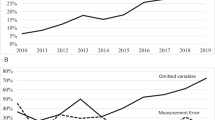Abstract
The subsidization of a natural monopoly is justified on welfare-economic grounds if the resulting total economic surplus exceeds total costs. Using rather standard assumptions, a simple check, managing with a minimum of information and, in particular, without virtually any knowledge of the demand curve, is developed which is capable of confirming an existing economic case for subsidization.
Similar content being viewed by others
References
Dupuit, J.E. (1844). De la mesure de l'utilité des travaux publics. Annales des Ponts et Chaussées (2e série) VIII.
Harberger, A.C. (1971). Three basic postulates of applied welfare economics: An interpretative essay. Journal of Economic Literature 9: 785–797.
Hicks, J.R. (1941). The rehabilitation of consumer's surplus. Review of Economic Studies 8: 108–116.
Schimmelpfennig, J. (1997). Demand for ballet: A non-parametric analysis of the 1995 Royal Ballet Summer Season. Journal of Cultural Economics 21: 119–127.
Author information
Authors and Affiliations
Rights and permissions
About this article
Cite this article
Schimmelpfennig, J. The one-third rule: Learning about the net economic benefit of a subsidy from a single observation. Public Choice 95, 331–334 (1998). https://doi.org/10.1023/A:1005019205780
Issue Date:
DOI: https://doi.org/10.1023/A:1005019205780




